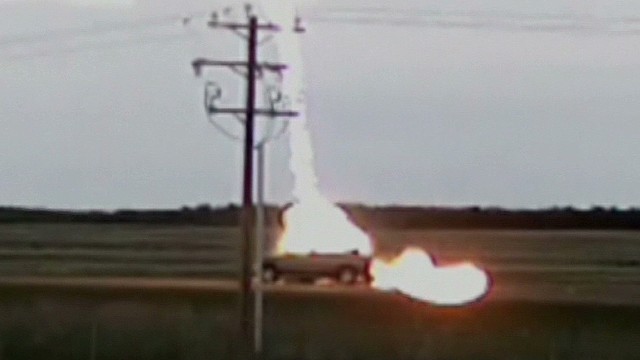Lightning, that ephemeral dance of electricity that ignites the sky and sparks our imaginations, is a phenomenon both mesmerizing and terrifying. Often, when we think of lightning, we conjure images of towering bolts illuminating the night and landscapes, crackling the air with raw energy. But amidst this incandescent display, an intriguing question arises: Can a car be struck by lightning? The answer, while straightforward, opens a pathway to understanding the intricate interplay between nature’s fury and human ingenuity.
Imagine, if you will, a sleek automobile gliding through a stormy landscape, the rain hammering against its roof like a thousand drummers in harmonious discord. This metal chariot, seemingly impervious, traverses the tempest, shielded by its own wonder of engineering. But just as a knight in shining armor might find himself confronted by a dragon, could this car, too, fall victim to the very forces that shape our world? The truth is that, yes, a car can be struck by lightning, but the consequences are often more benign than one might expect.
Lightning is a natural electrical discharge that occurs during thunderstorms, a release of energy from the atmospheric build-up that one could liken to the violent outburst of an over-pressurized soda bottle. When the conditions are ripe—warm, humid air colliding with cooler currents—this charged tension creates the ideal scenario for lightning to strike. As the bolt seeks a path to the earth, it can indeed be drawn to the metallic structure of an automobile.
However, the design of modern vehicles carries a remarkable throat-clearing grace in the face of such chaos. Cars are predominantly constructed with a metal frame that essentially acts like a Faraday cage, a shelter against electrical discharges. When lightning strikes a car, the electric energy travels along the exterior of the vehicle, dissipating harmlessly into the ground. Passengers inside, enveloped in a cocoon of insulation, are usually left unscathed, provided they adhere to basic safety protocols.
This notion of the automobile as a protective vessel against nature’s wrath is a comforting one. It is like a ship navigating turbulent seas, buoyed by its hull, or a fortress standing firm against the onslaught of relentless rain and wind. The key is to avoid contact with metal objects within the vehicle, such as door handles or a radio antenna, to greatly reduce any risk of injury from the surge of electrical energy. With this knowledge, traveling during a storm can transform from an act of trepidation to one of informed caution.
Despite these assurances, there remain many myths surrounding lightning strikes and vehicles. One common misconception is that a car, when parked beneath a tree or near an elevated object, is somehow safer from a strike. In reality, such positioning could increase the risk of being struck indirectly, as trees can act as conductors that channel lightning energy. Understanding the landscape and making wise decisions about where to park during storms can mitigate risks significantly.
Moreover, not all vehicles are created equal in terms of lightning protection. While the metal framework of a car generally offers a shield, certain features—such as removable soft tops on convertibles—can compromise this protection. A convertible in a storm is akin to leaving the windows open during a deluge: you may end up completely drenched, both from the elements and potentially, from the undesirable jolt of an unexpected lightning strike.
Interestingly, even though cars can be struck by lightning, instances of this occurrence are rare. According to atmospheric data, the likelihood ranges roughly from 1 in 3 million to 1 in 30 million per year, depending on geographical location and local weather patterns. This infrequent phenomenon elevates the mystique surrounding lightning, marking it as one of nature’s wild cards.
The allure of lightning doesn’t stop at its capacity to strike vehicles; it serves as a reminder of our place in the hierarchy of forces. The tension between humanity’s creations and the primal ferocity of the natural world invites exploration of broader themes of resilience and adaptability. Even as vehicles evolve, equipped now with advanced technologies and safety measures, they remain beholden to the unpredictable whims of nature.
In the grand tapestry of life, lightning strikes can be likened to unexpected events that jolts us from complacency. They force a reckoning with our environment that is both humbling and invigorating. Just as a lifted car far from a storm could still experience a surge of electricity through the air, our lives are punctuated by sudden changes and unforeseen circumstances. The way we respond to these upheavals—whether by seeking safety in knowledge or by braving the storm—determines the resilience we exhibit.
So, as you venture forth in your automobile engulfed in roiling thunderclouds, remember: while the thrill of lightning may capture your imagination, it is the integrity of your vehicle that holds the power of protection. The next time you see a bolt flash across the sky, let it not stir feelings of fear, but rather invoke a sense of reverence—recognizing the intersection of nature’s magnificence and humanity’s resilience against the elements. In the face of these grand electrical displays, we find a subtle balance, reminding us that we are all part of a much larger narrative, one where survival and wonder coexist.
